Individual Performance Related Pay, Motivation and Performance Essay
VerifiedAdded on 2022/08/23
|9
|2622
|27
Essay
AI Summary
This essay critically evaluates the concept of Individual Performance Related Pay (IPRP) and its influence on employee performance and motivation. It explores the benefits, such as directing employee efforts and aiding in staffing decisions, alongside the demerits, including potential for competition and short-term focus. The essay delves into various theories, including those of Yasser, Dr. Wasi, John Stacey Adams' equity theory, Maslow’s Hierarchy of Needs, and goal-setting theory, to provide a comprehensive understanding of IPRP. It also examines contextual factors like values, personality, and technology, and discusses circumstances where IPRP is most and least effective. The essay concludes by emphasizing the significance of IPRP in modern organizations, its role in motivating employees, and its impact on staffing and performance management.
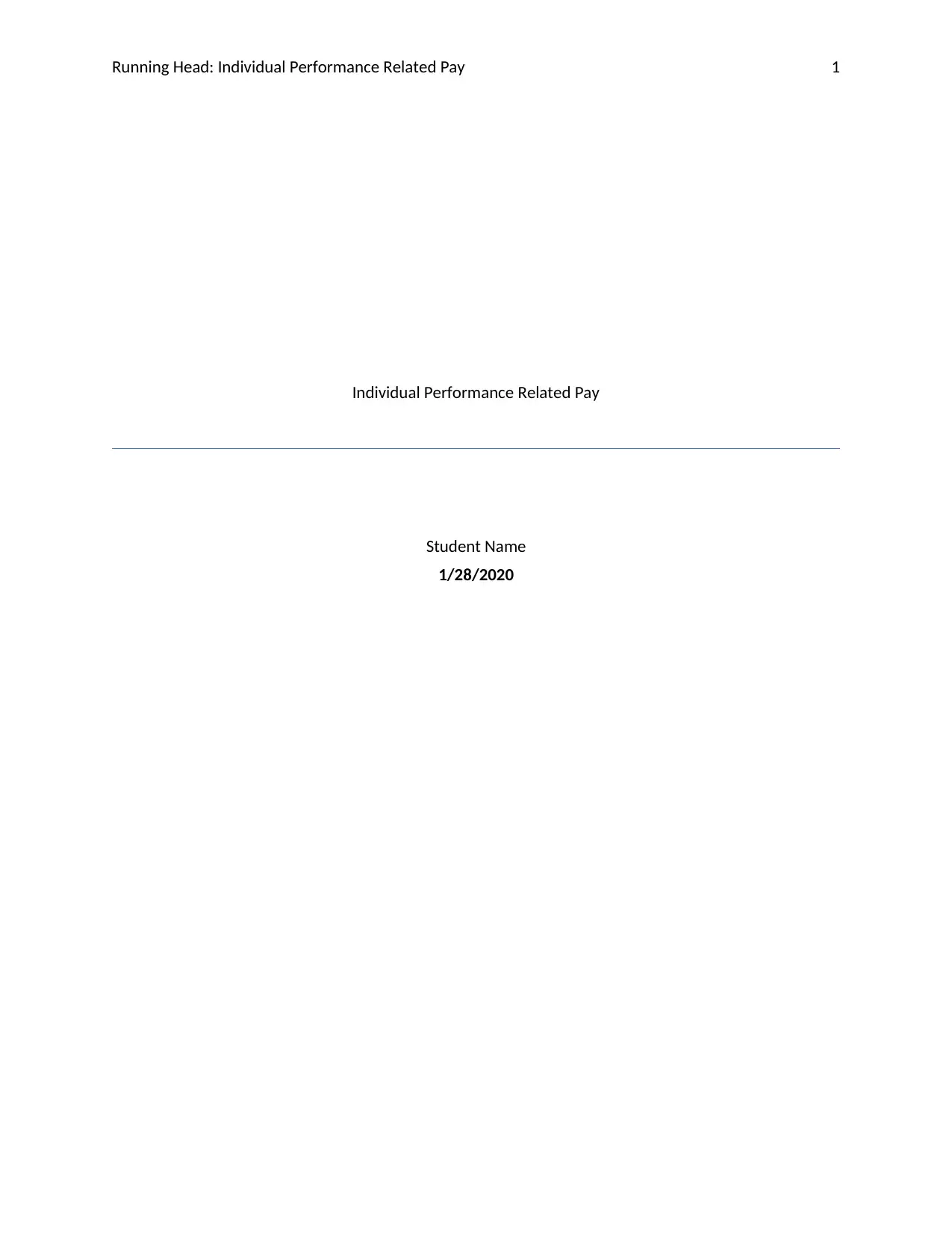
Running Head: Individual Performance Related Pay 1
Individual Performance Related Pay
Student Name
1/28/2020
Individual Performance Related Pay
Student Name
1/28/2020
Paraphrase This Document
Need a fresh take? Get an instant paraphrase of this document with our AI Paraphraser
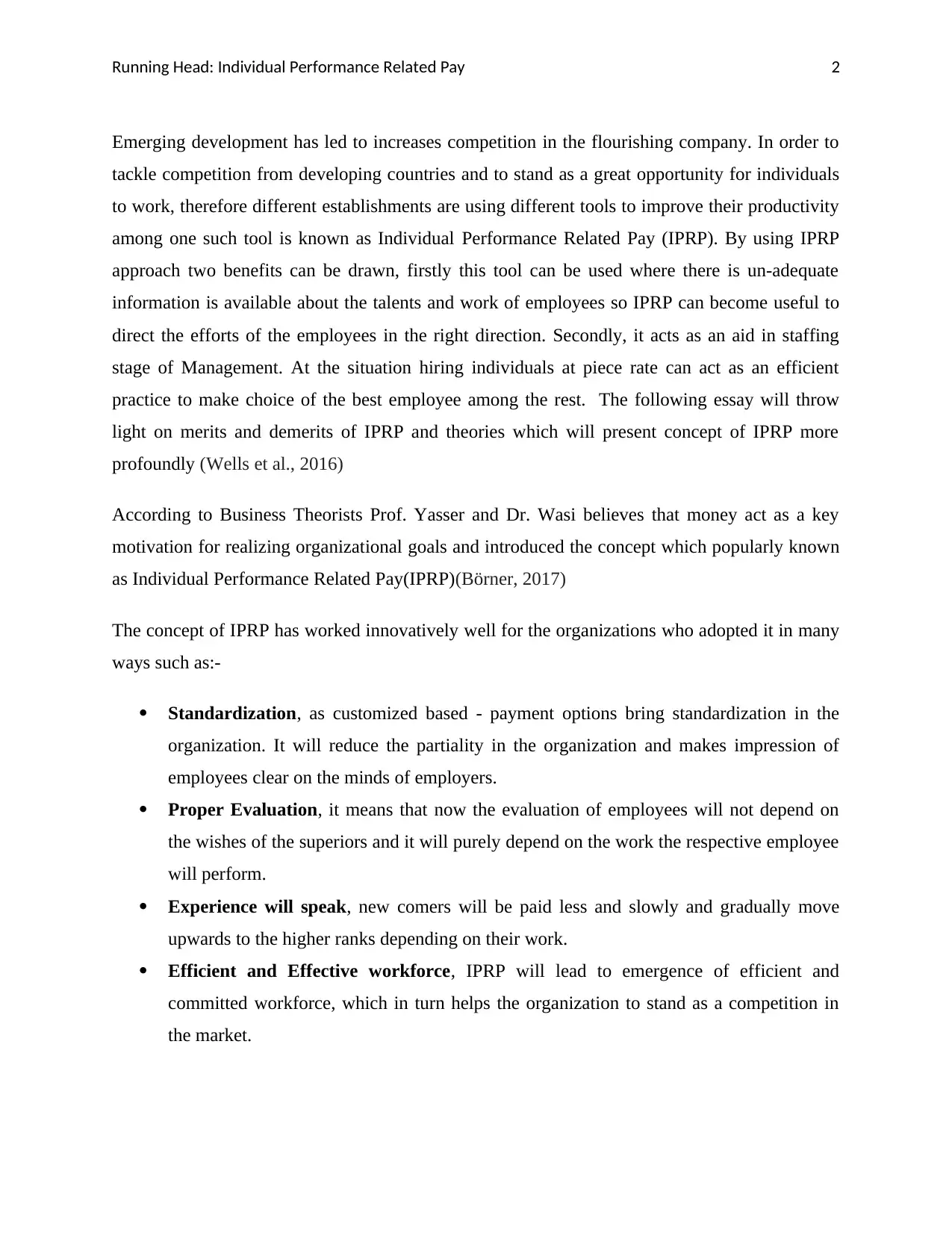
Running Head: Individual Performance Related Pay 2
Emerging development has led to increases competition in the flourishing company. In order to
tackle competition from developing countries and to stand as a great opportunity for individuals
to work, therefore different establishments are using different tools to improve their productivity
among one such tool is known as Individual Performance Related Pay (IPRP). By using IPRP
approach two benefits can be drawn, firstly this tool can be used where there is un-adequate
information is available about the talents and work of employees so IPRP can become useful to
direct the efforts of the employees in the right direction. Secondly, it acts as an aid in staffing
stage of Management. At the situation hiring individuals at piece rate can act as an efficient
practice to make choice of the best employee among the rest. The following essay will throw
light on merits and demerits of IPRP and theories which will present concept of IPRP more
profoundly (Wells et al., 2016)
According to Business Theorists Prof. Yasser and Dr. Wasi believes that money act as a key
motivation for realizing organizational goals and introduced the concept which popularly known
as Individual Performance Related Pay(IPRP)(Börner, 2017)
The concept of IPRP has worked innovatively well for the organizations who adopted it in many
ways such as:-
Standardization, as customized based - payment options bring standardization in the
organization. It will reduce the partiality in the organization and makes impression of
employees clear on the minds of employers.
Proper Evaluation, it means that now the evaluation of employees will not depend on
the wishes of the superiors and it will purely depend on the work the respective employee
will perform.
Experience will speak, new comers will be paid less and slowly and gradually move
upwards to the higher ranks depending on their work.
Efficient and Effective workforce, IPRP will lead to emergence of efficient and
committed workforce, which in turn helps the organization to stand as a competition in
the market.
Emerging development has led to increases competition in the flourishing company. In order to
tackle competition from developing countries and to stand as a great opportunity for individuals
to work, therefore different establishments are using different tools to improve their productivity
among one such tool is known as Individual Performance Related Pay (IPRP). By using IPRP
approach two benefits can be drawn, firstly this tool can be used where there is un-adequate
information is available about the talents and work of employees so IPRP can become useful to
direct the efforts of the employees in the right direction. Secondly, it acts as an aid in staffing
stage of Management. At the situation hiring individuals at piece rate can act as an efficient
practice to make choice of the best employee among the rest. The following essay will throw
light on merits and demerits of IPRP and theories which will present concept of IPRP more
profoundly (Wells et al., 2016)
According to Business Theorists Prof. Yasser and Dr. Wasi believes that money act as a key
motivation for realizing organizational goals and introduced the concept which popularly known
as Individual Performance Related Pay(IPRP)(Börner, 2017)
The concept of IPRP has worked innovatively well for the organizations who adopted it in many
ways such as:-
Standardization, as customized based - payment options bring standardization in the
organization. It will reduce the partiality in the organization and makes impression of
employees clear on the minds of employers.
Proper Evaluation, it means that now the evaluation of employees will not depend on
the wishes of the superiors and it will purely depend on the work the respective employee
will perform.
Experience will speak, new comers will be paid less and slowly and gradually move
upwards to the higher ranks depending on their work.
Efficient and Effective workforce, IPRP will lead to emergence of efficient and
committed workforce, which in turn helps the organization to stand as a competition in
the market.
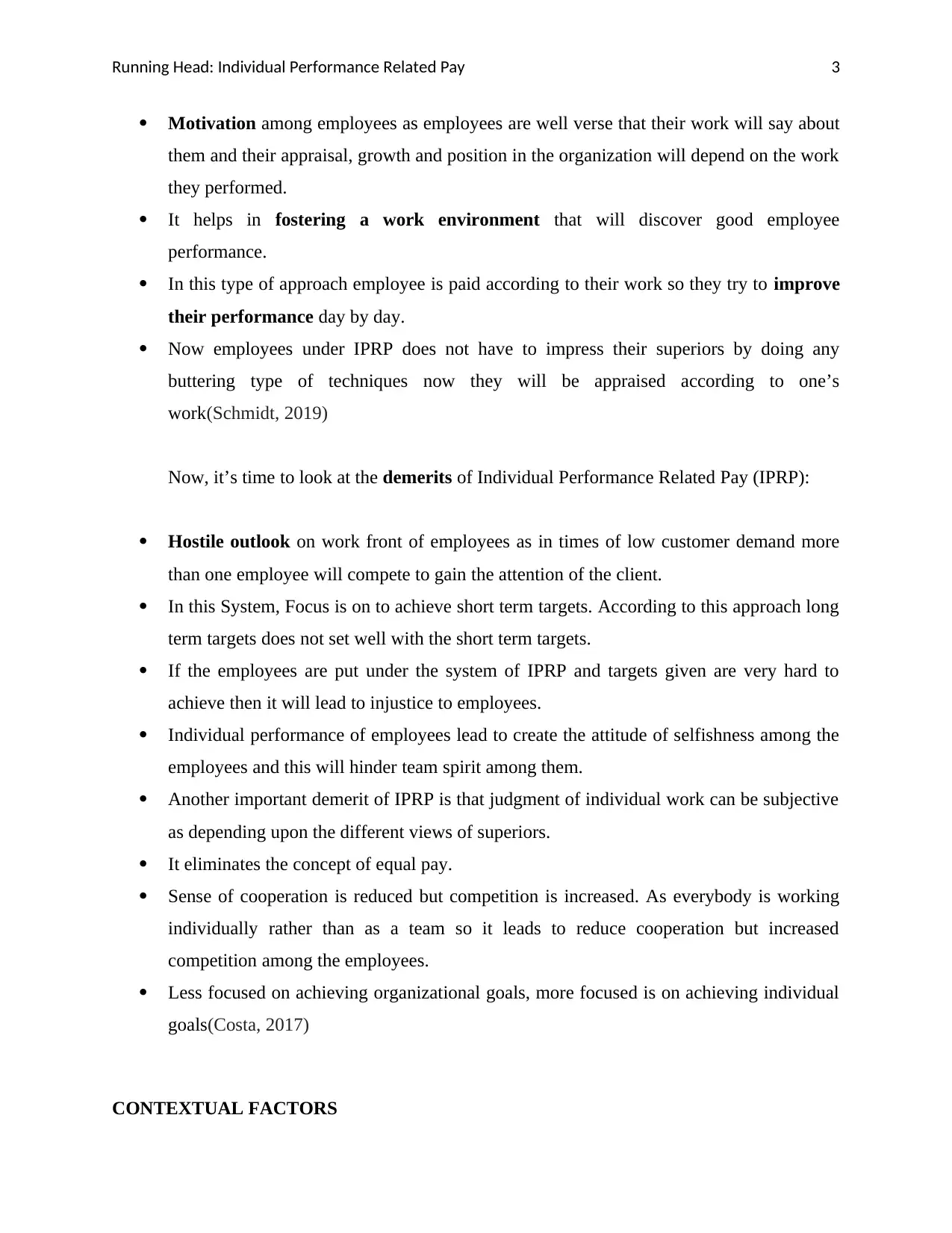
Running Head: Individual Performance Related Pay 3
Motivation among employees as employees are well verse that their work will say about
them and their appraisal, growth and position in the organization will depend on the work
they performed.
It helps in fostering a work environment that will discover good employee
performance.
In this type of approach employee is paid according to their work so they try to improve
their performance day by day.
Now employees under IPRP does not have to impress their superiors by doing any
buttering type of techniques now they will be appraised according to one’s
work(Schmidt, 2019)
Now, it’s time to look at the demerits of Individual Performance Related Pay (IPRP):
Hostile outlook on work front of employees as in times of low customer demand more
than one employee will compete to gain the attention of the client.
In this System, Focus is on to achieve short term targets. According to this approach long
term targets does not set well with the short term targets.
If the employees are put under the system of IPRP and targets given are very hard to
achieve then it will lead to injustice to employees.
Individual performance of employees lead to create the attitude of selfishness among the
employees and this will hinder team spirit among them.
Another important demerit of IPRP is that judgment of individual work can be subjective
as depending upon the different views of superiors.
It eliminates the concept of equal pay.
Sense of cooperation is reduced but competition is increased. As everybody is working
individually rather than as a team so it leads to reduce cooperation but increased
competition among the employees.
Less focused on achieving organizational goals, more focused is on achieving individual
goals(Costa, 2017)
CONTEXTUAL FACTORS
Motivation among employees as employees are well verse that their work will say about
them and their appraisal, growth and position in the organization will depend on the work
they performed.
It helps in fostering a work environment that will discover good employee
performance.
In this type of approach employee is paid according to their work so they try to improve
their performance day by day.
Now employees under IPRP does not have to impress their superiors by doing any
buttering type of techniques now they will be appraised according to one’s
work(Schmidt, 2019)
Now, it’s time to look at the demerits of Individual Performance Related Pay (IPRP):
Hostile outlook on work front of employees as in times of low customer demand more
than one employee will compete to gain the attention of the client.
In this System, Focus is on to achieve short term targets. According to this approach long
term targets does not set well with the short term targets.
If the employees are put under the system of IPRP and targets given are very hard to
achieve then it will lead to injustice to employees.
Individual performance of employees lead to create the attitude of selfishness among the
employees and this will hinder team spirit among them.
Another important demerit of IPRP is that judgment of individual work can be subjective
as depending upon the different views of superiors.
It eliminates the concept of equal pay.
Sense of cooperation is reduced but competition is increased. As everybody is working
individually rather than as a team so it leads to reduce cooperation but increased
competition among the employees.
Less focused on achieving organizational goals, more focused is on achieving individual
goals(Costa, 2017)
CONTEXTUAL FACTORS
⊘ This is a preview!⊘
Do you want full access?
Subscribe today to unlock all pages.

Trusted by 1+ million students worldwide

Running Head: Individual Performance Related Pay 4
Increased employee cooperation represents a vital objective for establishments. Because of
fulfilling this objective organization directs their efforts in improving individual’s performance.
But in this way of improving individual performance some contextual factors are drawn up such
as values, cultural norms, new technologies, etc. There are various issues related known as
contextual issues which are faced during running the organization such as:-
Values, it refers to the one’s life goals that reflect their preferences that are what is at priority to
them in their lives. Values are built by collecting one’s experiences. Value plays an important
role in type of decisions they made. Many a time’s people accept job from a company which
possesses value. Instrumental values define the limits of their conduct, honesty etc(Vismara,
2016)
Personality, it consists of behavioral attributes about an employee which separates individual
from individual. By having knowledge about the employee’s personality it helps the employer to
decide the work for each and every employee which leads to specialization(McCarthy, 2018)
Another one is types of occupation, it is also one of the important factor which helps to show
interest of the workforce, it throws light on the area of work they want to work in. This helps the
employer to put the correct staff at correct position(Costa, 2017)
Individual Differences, it acts as a barrier for the employer which does not set well with the team
spirit and create unrest among the employees and create tension in the environment. Also,
relationship which the employees share within the organization matters a lot as this is one of the
basis of the building the efficient organization. It is the basic requirement of every of every
organization that they must have employee relationship(Torres-Robles etal., 2019)
Organizational support also acts as a motivation for the employees. Such type of organization
which supports their employees, helps them to work even better and also acts as an aid to
discover initiative present among the employees(Popovic, et al., 2016)
Technology is very important and acts as a support system for employees, better and newer
technologies will lead to faster competition of targets which will lead to achieve individual goals
parallel with organizational goals. Outdated technology leads to slower accomplishment of
targets. Technology needs teamwork, togetherness of employees facilitates growth of the
Increased employee cooperation represents a vital objective for establishments. Because of
fulfilling this objective organization directs their efforts in improving individual’s performance.
But in this way of improving individual performance some contextual factors are drawn up such
as values, cultural norms, new technologies, etc. There are various issues related known as
contextual issues which are faced during running the organization such as:-
Values, it refers to the one’s life goals that reflect their preferences that are what is at priority to
them in their lives. Values are built by collecting one’s experiences. Value plays an important
role in type of decisions they made. Many a time’s people accept job from a company which
possesses value. Instrumental values define the limits of their conduct, honesty etc(Vismara,
2016)
Personality, it consists of behavioral attributes about an employee which separates individual
from individual. By having knowledge about the employee’s personality it helps the employer to
decide the work for each and every employee which leads to specialization(McCarthy, 2018)
Another one is types of occupation, it is also one of the important factor which helps to show
interest of the workforce, it throws light on the area of work they want to work in. This helps the
employer to put the correct staff at correct position(Costa, 2017)
Individual Differences, it acts as a barrier for the employer which does not set well with the team
spirit and create unrest among the employees and create tension in the environment. Also,
relationship which the employees share within the organization matters a lot as this is one of the
basis of the building the efficient organization. It is the basic requirement of every of every
organization that they must have employee relationship(Torres-Robles etal., 2019)
Organizational support also acts as a motivation for the employees. Such type of organization
which supports their employees, helps them to work even better and also acts as an aid to
discover initiative present among the employees(Popovic, et al., 2016)
Technology is very important and acts as a support system for employees, better and newer
technologies will lead to faster competition of targets which will lead to achieve individual goals
parallel with organizational goals. Outdated technology leads to slower accomplishment of
targets. Technology needs teamwork, togetherness of employees facilitates growth of the
Paraphrase This Document
Need a fresh take? Get an instant paraphrase of this document with our AI Paraphraser

Running Head: Individual Performance Related Pay 5
organization. Teamwork represents good relations among the organization. This act as a good
tool for building the strong organization and problem solving also become all the more easy
when more than one brain is applied(Fiala, 2017)
There are many reasons in the organization due to which there in need to introduce IPRP. The
IPRP is vital in today’s market and supports every organization at large. The IPRP motivates
inner strength of employees and force towards the goals attainment. The organizations for
fulfilling their requirements and to keep employees happy need to introduce IPRP. One of the
reasons for introducing IPRP is retention of employees for longer period. There are theories
which relates to employee motivation. The theories give proper guidance for motivating each and
every employee performance(Grimshaw, 2016)
John Stacey Adam’s has given equity theory. The theory states that the pay is an important tool
need to be focused with motivation. Equity in pay and fairly treatment of an employee will
motivate employees more towards the organizations goal. In equity there are two main terms
inputs and outputs. Inputs refer to quality and quantity of employees contributions in the
organization. Inputs include time, efforts, loyalty, values, ability, patience, faith, honesty and
support where as output means everything we take out in return. It includes both intangible and
tangible outputs such as, employee benefits, expenses, reputation, responsibility and esteem. If
there will be equity in the organization for employees then employees will work with full
efficiency and courage and it increases productivity, revenue, retention etc(Neher, 2010)
Another theory is Maslow’s Hierarch Theory, it comprises for five-tier model of human needs.
The needs are depicted in hierarchical levels within a pyramid. The model consist of needs are
self-actualization, self-esteem, love and belonging, safety needs and physiological needs. The
employees will perform and give their best when their needs are satisfied. The Maslow’s theory
is for employees satisfaction and the order of needs are not rigid even they are flexible(Perry,
Engbers, and Jun, 2017)
The goals of organization need to be clear and specific for better performance of the employees.
Therefore, there is goal-setting theory which set goals for every employee and after attaining it
rewards are given. The enthusiasms to work and achieve goals are the main motivation source
for an employee. The harder and challenging goals will create more willingness in employees to
organization. Teamwork represents good relations among the organization. This act as a good
tool for building the strong organization and problem solving also become all the more easy
when more than one brain is applied(Fiala, 2017)
There are many reasons in the organization due to which there in need to introduce IPRP. The
IPRP is vital in today’s market and supports every organization at large. The IPRP motivates
inner strength of employees and force towards the goals attainment. The organizations for
fulfilling their requirements and to keep employees happy need to introduce IPRP. One of the
reasons for introducing IPRP is retention of employees for longer period. There are theories
which relates to employee motivation. The theories give proper guidance for motivating each and
every employee performance(Grimshaw, 2016)
John Stacey Adam’s has given equity theory. The theory states that the pay is an important tool
need to be focused with motivation. Equity in pay and fairly treatment of an employee will
motivate employees more towards the organizations goal. In equity there are two main terms
inputs and outputs. Inputs refer to quality and quantity of employees contributions in the
organization. Inputs include time, efforts, loyalty, values, ability, patience, faith, honesty and
support where as output means everything we take out in return. It includes both intangible and
tangible outputs such as, employee benefits, expenses, reputation, responsibility and esteem. If
there will be equity in the organization for employees then employees will work with full
efficiency and courage and it increases productivity, revenue, retention etc(Neher, 2010)
Another theory is Maslow’s Hierarch Theory, it comprises for five-tier model of human needs.
The needs are depicted in hierarchical levels within a pyramid. The model consist of needs are
self-actualization, self-esteem, love and belonging, safety needs and physiological needs. The
employees will perform and give their best when their needs are satisfied. The Maslow’s theory
is for employees satisfaction and the order of needs are not rigid even they are flexible(Perry,
Engbers, and Jun, 2017)
The goals of organization need to be clear and specific for better performance of the employees.
Therefore, there is goal-setting theory which set goals for every employee and after attaining it
rewards are given. The enthusiasms to work and achieve goals are the main motivation source
for an employee. The harder and challenging goals will create more willingness in employees to
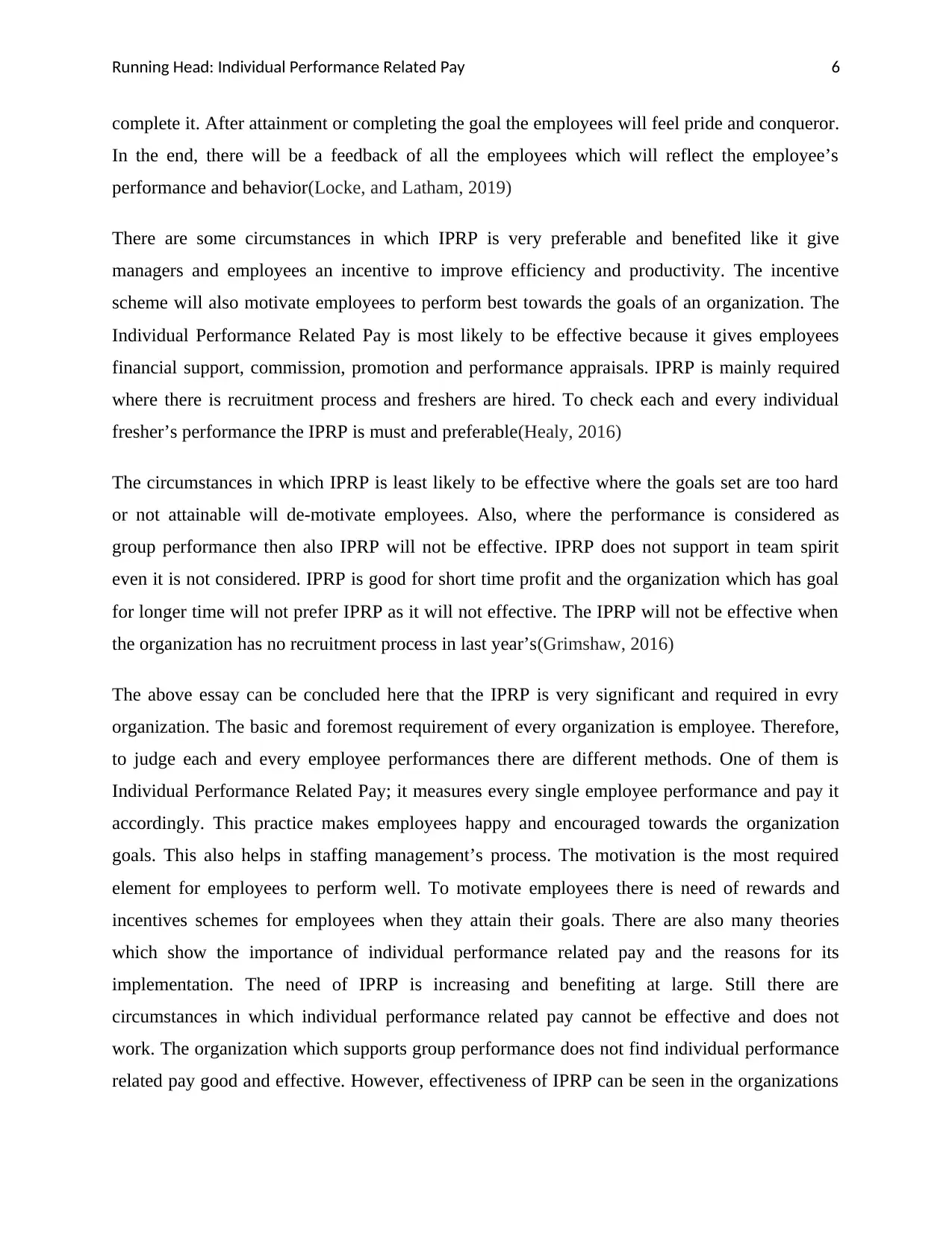
Running Head: Individual Performance Related Pay 6
complete it. After attainment or completing the goal the employees will feel pride and conqueror.
In the end, there will be a feedback of all the employees which will reflect the employee’s
performance and behavior(Locke, and Latham, 2019)
There are some circumstances in which IPRP is very preferable and benefited like it give
managers and employees an incentive to improve efficiency and productivity. The incentive
scheme will also motivate employees to perform best towards the goals of an organization. The
Individual Performance Related Pay is most likely to be effective because it gives employees
financial support, commission, promotion and performance appraisals. IPRP is mainly required
where there is recruitment process and freshers are hired. To check each and every individual
fresher’s performance the IPRP is must and preferable(Healy, 2016)
The circumstances in which IPRP is least likely to be effective where the goals set are too hard
or not attainable will de-motivate employees. Also, where the performance is considered as
group performance then also IPRP will not be effective. IPRP does not support in team spirit
even it is not considered. IPRP is good for short time profit and the organization which has goal
for longer time will not prefer IPRP as it will not effective. The IPRP will not be effective when
the organization has no recruitment process in last year’s(Grimshaw, 2016)
The above essay can be concluded here that the IPRP is very significant and required in evry
organization. The basic and foremost requirement of every organization is employee. Therefore,
to judge each and every employee performances there are different methods. One of them is
Individual Performance Related Pay; it measures every single employee performance and pay it
accordingly. This practice makes employees happy and encouraged towards the organization
goals. This also helps in staffing management’s process. The motivation is the most required
element for employees to perform well. To motivate employees there is need of rewards and
incentives schemes for employees when they attain their goals. There are also many theories
which show the importance of individual performance related pay and the reasons for its
implementation. The need of IPRP is increasing and benefiting at large. Still there are
circumstances in which individual performance related pay cannot be effective and does not
work. The organization which supports group performance does not find individual performance
related pay good and effective. However, effectiveness of IPRP can be seen in the organizations
complete it. After attainment or completing the goal the employees will feel pride and conqueror.
In the end, there will be a feedback of all the employees which will reflect the employee’s
performance and behavior(Locke, and Latham, 2019)
There are some circumstances in which IPRP is very preferable and benefited like it give
managers and employees an incentive to improve efficiency and productivity. The incentive
scheme will also motivate employees to perform best towards the goals of an organization. The
Individual Performance Related Pay is most likely to be effective because it gives employees
financial support, commission, promotion and performance appraisals. IPRP is mainly required
where there is recruitment process and freshers are hired. To check each and every individual
fresher’s performance the IPRP is must and preferable(Healy, 2016)
The circumstances in which IPRP is least likely to be effective where the goals set are too hard
or not attainable will de-motivate employees. Also, where the performance is considered as
group performance then also IPRP will not be effective. IPRP does not support in team spirit
even it is not considered. IPRP is good for short time profit and the organization which has goal
for longer time will not prefer IPRP as it will not effective. The IPRP will not be effective when
the organization has no recruitment process in last year’s(Grimshaw, 2016)
The above essay can be concluded here that the IPRP is very significant and required in evry
organization. The basic and foremost requirement of every organization is employee. Therefore,
to judge each and every employee performances there are different methods. One of them is
Individual Performance Related Pay; it measures every single employee performance and pay it
accordingly. This practice makes employees happy and encouraged towards the organization
goals. This also helps in staffing management’s process. The motivation is the most required
element for employees to perform well. To motivate employees there is need of rewards and
incentives schemes for employees when they attain their goals. There are also many theories
which show the importance of individual performance related pay and the reasons for its
implementation. The need of IPRP is increasing and benefiting at large. Still there are
circumstances in which individual performance related pay cannot be effective and does not
work. The organization which supports group performance does not find individual performance
related pay good and effective. However, effectiveness of IPRP can be seen in the organizations
⊘ This is a preview!⊘
Do you want full access?
Subscribe today to unlock all pages.

Trusted by 1+ million students worldwide

Running Head: Individual Performance Related Pay 7
where there is need of management of staff. Also, IPRP helps to check and test the performance
of individuals by applying techniques. By this every individual employee performance can be
ascertained easily.
where there is need of management of staff. Also, IPRP helps to check and test the performance
of individuals by applying techniques. By this every individual employee performance can be
ascertained easily.
Paraphrase This Document
Need a fresh take? Get an instant paraphrase of this document with our AI Paraphraser
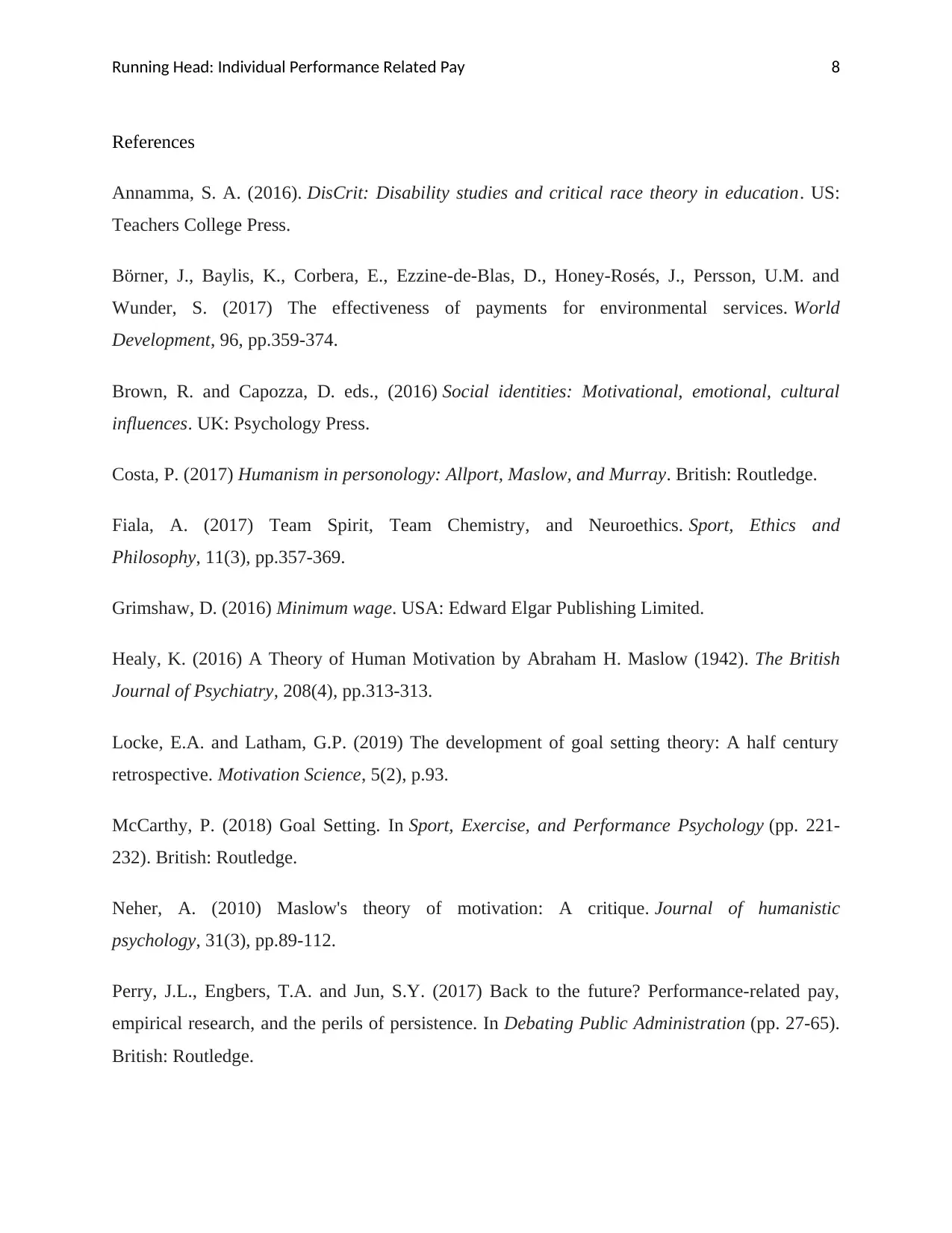
Running Head: Individual Performance Related Pay 8
References
Annamma, S. A. (2016). DisCrit: Disability studies and critical race theory in education. US:
Teachers College Press.
Börner, J., Baylis, K., Corbera, E., Ezzine-de-Blas, D., Honey-Rosés, J., Persson, U.M. and
Wunder, S. (2017) The effectiveness of payments for environmental services. World
Development, 96, pp.359-374.
Brown, R. and Capozza, D. eds., (2016) Social identities: Motivational, emotional, cultural
influences. UK: Psychology Press.
Costa, P. (2017) Humanism in personology: Allport, Maslow, and Murray. British: Routledge.
Fiala, A. (2017) Team Spirit, Team Chemistry, and Neuroethics. Sport, Ethics and
Philosophy, 11(3), pp.357-369.
Grimshaw, D. (2016) Minimum wage. USA: Edward Elgar Publishing Limited.
Healy, K. (2016) A Theory of Human Motivation by Abraham H. Maslow (1942). The British
Journal of Psychiatry, 208(4), pp.313-313.
Locke, E.A. and Latham, G.P. (2019) The development of goal setting theory: A half century
retrospective. Motivation Science, 5(2), p.93.
McCarthy, P. (2018) Goal Setting. In Sport, Exercise, and Performance Psychology (pp. 221-
232). British: Routledge.
Neher, A. (2010) Maslow's theory of motivation: A critique. Journal of humanistic
psychology, 31(3), pp.89-112.
Perry, J.L., Engbers, T.A. and Jun, S.Y. (2017) Back to the future? Performance-related pay,
empirical research, and the perils of persistence. In Debating Public Administration (pp. 27-65).
British: Routledge.
References
Annamma, S. A. (2016). DisCrit: Disability studies and critical race theory in education. US:
Teachers College Press.
Börner, J., Baylis, K., Corbera, E., Ezzine-de-Blas, D., Honey-Rosés, J., Persson, U.M. and
Wunder, S. (2017) The effectiveness of payments for environmental services. World
Development, 96, pp.359-374.
Brown, R. and Capozza, D. eds., (2016) Social identities: Motivational, emotional, cultural
influences. UK: Psychology Press.
Costa, P. (2017) Humanism in personology: Allport, Maslow, and Murray. British: Routledge.
Fiala, A. (2017) Team Spirit, Team Chemistry, and Neuroethics. Sport, Ethics and
Philosophy, 11(3), pp.357-369.
Grimshaw, D. (2016) Minimum wage. USA: Edward Elgar Publishing Limited.
Healy, K. (2016) A Theory of Human Motivation by Abraham H. Maslow (1942). The British
Journal of Psychiatry, 208(4), pp.313-313.
Locke, E.A. and Latham, G.P. (2019) The development of goal setting theory: A half century
retrospective. Motivation Science, 5(2), p.93.
McCarthy, P. (2018) Goal Setting. In Sport, Exercise, and Performance Psychology (pp. 221-
232). British: Routledge.
Neher, A. (2010) Maslow's theory of motivation: A critique. Journal of humanistic
psychology, 31(3), pp.89-112.
Perry, J.L., Engbers, T.A. and Jun, S.Y. (2017) Back to the future? Performance-related pay,
empirical research, and the perils of persistence. In Debating Public Administration (pp. 27-65).
British: Routledge.

Running Head: Individual Performance Related Pay 9
Popovic, M., Mohiuddin, M., Tomozei, D. C., & Le Boudec, J. Y. (2016). iPRP—The parallel
redundancy protocol for IP networks: Protocol design and operation. IEEE Transactions on
Industrial Informatics, 12(5), 1842-1854.
Schmidt, G.B. (2019) The need for goal-setting theory and motivation constructs in Lean
management. Industrial and Organizational Psychology, 12(3), pp.251-254.
Torres-Robles, A., Wiecek, E., Cutler, R.L., Drake, B., Fernandez-Llimos, F. and Garcia-
Cardenas, V. (2019) Using dispensing data to evaluate adherence implementation rates in
community pharmacy. Frontiers in pharmacology, 10, p.130.
Vismara, S. (2016) Equity retention and social network theory in equity crowdfunding. Small
Business Economics, 46(4), pp.579-590.
Wells, G., Fisher, J.A., Porras, I., Staddon, S. and Ryan, C. (2017) Rethinking monitoring in
smallholder carbon payments for ecosystem service schemes: devolve monitoring, understand
accuracy and identify co-benefits. Ecological economics, 139, pp.115-127.
Popovic, M., Mohiuddin, M., Tomozei, D. C., & Le Boudec, J. Y. (2016). iPRP—The parallel
redundancy protocol for IP networks: Protocol design and operation. IEEE Transactions on
Industrial Informatics, 12(5), 1842-1854.
Schmidt, G.B. (2019) The need for goal-setting theory and motivation constructs in Lean
management. Industrial and Organizational Psychology, 12(3), pp.251-254.
Torres-Robles, A., Wiecek, E., Cutler, R.L., Drake, B., Fernandez-Llimos, F. and Garcia-
Cardenas, V. (2019) Using dispensing data to evaluate adherence implementation rates in
community pharmacy. Frontiers in pharmacology, 10, p.130.
Vismara, S. (2016) Equity retention and social network theory in equity crowdfunding. Small
Business Economics, 46(4), pp.579-590.
Wells, G., Fisher, J.A., Porras, I., Staddon, S. and Ryan, C. (2017) Rethinking monitoring in
smallholder carbon payments for ecosystem service schemes: devolve monitoring, understand
accuracy and identify co-benefits. Ecological economics, 139, pp.115-127.
⊘ This is a preview!⊘
Do you want full access?
Subscribe today to unlock all pages.

Trusted by 1+ million students worldwide
1 out of 9
Related Documents
Your All-in-One AI-Powered Toolkit for Academic Success.
+13062052269
info@desklib.com
Available 24*7 on WhatsApp / Email
![[object Object]](/_next/static/media/star-bottom.7253800d.svg)
Unlock your academic potential
© 2024 | Zucol Services PVT LTD | All rights reserved.





